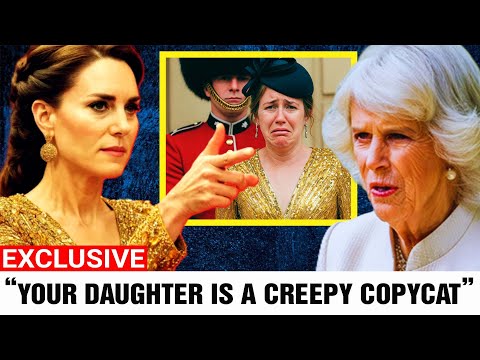Kate Middleton’s Classy Clap back Leaves Camilla’s Copycat Daughter Red-Faced at Royal Banquet!

In the gilded halls of Buckingham Palace, where every gesture is scrutinized and every word carries weight, a quiet but compelling drama has unfolded. At the heart of it are two women: Catherine, Princess of Wales, known to the world as Kate Middleton, and Laura Lopes, daughter of Queen Camilla. What began as a subtle undercurrent of imitation has escalated into a masterclass of royal maneuvering, with Kate delivering a clever, veiled insult that not only asserted her dominance but also quashed Camilla’s rumored ambitions to elevate her daughter as a rival to the future queen.
This is a story of poise, power, and the unspoken rules of the House of Windsor—a tale that reveals the complexities of loyalty, legacy, and ambition in the modern monarchy.
Kate Middleton, with her polished demeanor and unwavering commitment to duty, has long been a cornerstone of the royal family’s public image. Since her marriage to Prince William in 2011, she has navigated the complexities of royal life with grace, earning admiration for her charity work, her relatable parenting, and her ability to modernize the monarchy without overshadowing its traditions. Her journey from a commoner to the Princess of Wales has been marked by a careful balance of accessibility and regality, making her a beloved figure worldwide.
Laura Lopes, by contrast, has lived a quieter life, largely out of the royal spotlight. The daughter of Camilla Parker Bowles and her first husband, Andrew Parker Bowles, Laura has pursued a career in the arts, running galleries and curating exhibitions. Married to Harry Lopes, a former model turned accountant, she has three children and maintains a low profile, occasionally appearing at royal events like weddings or coronations. Yet, in recent years, whispers have emerged that Laura, bolstered by her mother’s position as queen consort, harbors ambitions to step into a more prominent role, perhaps even to challenge Kate’s place as the monarchy’s leading lady.
The tension between Kate and Laura began subtly, almost imperceptibly, in the social circles of London’s elite. Observers noted Laura’s increasing presence at high-profile charity galas and cultural events, often mirroring Kate’s signature style. Where Kate wore a tailored Jenny Packham gown in sapphire blue to a children’s hospital fundraiser, Laura appeared weeks later in a strikingly similar cobalt dress by the same designer at an art gallery opening. That wasn’t the only time the copycat moment happened. Laura has repeatedly worn designs strikingly similar to Kate’s, often just days apart. When Kate championed mental health initiatives through her Heads Together campaign, Laura launched a small, arts-based wellness program, citing creativity as a path to emotional resilience.
Even their public appearances began to echo one another. Laura adopted Kate’s habit of crouching to speak with children at events, a gesture that had become a hallmark of the princess’s warmth.
To the public, these similarities might have seemed coincidental, but within royal circles, they were interpreted as a calculated attempt by Laura to emulate and perhaps rival Kate’s influence. Sources close to the palace suggested that Camilla, proud of her daughter’s understated elegance, saw an opportunity to elevate Laura’s profile. After all, Camilla herself had transitioned from a controversial figure to a respected queen consort, and she may have believed Laura could follow a similar path, carving out a niche as a modern, relatable royal.
Some even speculated that Camilla harbored a bolder ambition: to position Laura as a potential replacement for Kate should the princess ever falter in her role. This notion, though audacious, was not entirely far-fetched. The royal family has a history of internal rivalries, from the tensions between Princess Diana and Prince Charles to the more recent rift between Prince Harry and Prince William. Camilla, a seasoned survivor of public scrutiny, understood the power of perception. By promoting Laura as a figure of grace and capability, she could subtly shift the narrative, presenting her daughter as a viable alternative to Kate, a backup plan, perhaps, in an unpredictable world.
Kate, however, was not one to be outmaneuvered. Known for her strategic mind and quiet resilience, she observed Laura’s actions with a keen eye. Rather than confront the imitation directly—a move that risked appearing petty or insecure—Kate chose a more sophisticated approach. Her response came at a state banquet in honor of a visiting European dignitary, an event attended by the extended royal family, including Laura and Camilla. The evening was a glittering affair, with chandeliers casting light over long tables adorned with crystal and silver. Kate, as always, was a vision in a bespoke Alexander McQueen gown, its emerald hue a nod to the guest nation’s colors. Laura, seated further down the table, wore a dress in a nearly identical shade, prompting murmurs among the guests.
As the evening progressed, Kate was called upon to deliver a brief speech welcoming the dignitaries. Her words were warm and diplomatic, praising the shared cultural heritage of the two nations and emphasizing the importance of individuality in strengthening alliances. Then, with a smile that was both gracious and pointed, she added, “In a world that thrives on connection, there is beauty in forging one’s own path, distinct and true, rather than walking in another’s shadow.”
The remark was met with polite applause, but those in the know caught the subtext. It was a masterstroke, a compliment to authenticity that doubled as a subtle rebuke to Laura’s mimicry.
The impact was immediate. Guests exchanged glances, and Laura’s expression, though composed, betrayed a flicker of discomfort. Camilla, seated beside King Charles, maintained her usual poise. But sources later reported that she was quietly furious at the implication that her daughter was merely copying Kate. The press, ever eager for royal intrigue, picked up on the moment, with tabloids running headlines like “Kate’s Clever Clapback” and “Princess Puts Copycat in Her Place.” Social media buzzed with speculation, with royal watchers praising Kate’s elegance in addressing the rivalry without stooping to confrontation.
The banquet incident marked a turning point. Laura’s appearances at high-profile events dwindled, and her public initiatives took on a more subdued tone. Whether by choice or necessity, she retreated from the spotlight, focusing instead on her family and private ventures. Camilla’s rumored ambitions for her daughter appeared to falter as the queen consort shifted her focus to supporting Charles during his ongoing health challenges. Kate, meanwhile, emerged stronger than ever, her position as the monarchy’s future queen consort reaffirmed.
But what drove this rivalry, and why did it matter? At its core, the tension between Kate and Laura reflected the broader dynamics of the royal family in a time of transition. With King Charles III’s reign underway and questions about the monarchy’s relevance persisting, every member of the family is under pressure to justify their place. Kate, as the mother of the future king, Prince George, carries the weight of ensuring the monarchy’s continuity. Her popularity and work ethic make her indispensable, but they also make her a target for those seeking to carve out their own legacy.
The broader implications of this episode extend beyond personal rivalries. It underscores the delicate balance of power within the royal family, where loyalty to the crown must coexist with individual ambition. Kate’s response demonstrated her mastery of this balance, blending diplomacy with assertiveness to protect her position without alienating her allies. It also highlighted her evolution from a newcomer to a formidable figure, one who understands the stakes of her role and plays the game with precision.
In the weeks following the banquet, Kate continued her public duties with characteristic warmth, visiting schools, hosting charity receptions, and sharing glimpses of her family life on social media. Her focus remained on her children, George, Charlotte, and Louis, and her causes, from early childhood development to mental health. Yet those close to her noted a renewed confidence, a quiet assurance that she had weathered another storm.






